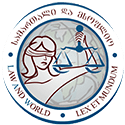| ციფრული იდენტიფიკატორი |
| doi.org/10.36475/L.A.W.14 |
| შემოკლება |
| L.A.W. |
| გამოცემა |
| ელ.ვერსია |
| ბეჭდური |
ამ სტატიაში
Volume 8, Issue 2
Judging the Freedom of Religion in India on the Touchtone of Doctrine of Essential Practice Test
Affiliation: Assistant Professor, Institute of Law, Nirma University, Ahmedabad (India)1,
Associate Professor, School of Law, Forensic Justice and Policy studies National Forensic Sciences University, Gandhinagar (India)2
Abstract: India is a secular nation where innumerable followers of religions, sects live. The Constitution of India gives the protection for freedom of religion. The protection is not available to all types of religious practices. This protection is available to only those practices which are essential to religion. Whether any religious practice is essential or not? To adjudicate this Indian Supreme Court has adopted the ‘Doctrine of Essential Practice Test’. This paper explore the development of this doctrine in India. This paper has been divide in six parts. First part gives a brief overview about people and their faith and their protection under constitution. Second part deals with the concept of secular state. Third part discuss about the meaning and concept of religion. Fourth part deals freedom of religion under Indian Constitution. Fifth part deals with doctrine of essential practice test. Sixth and last gives the conclusion.
Keywords: Secularism, Freedom of Religion, Fundamental Rights, Constitution of India
Language: EN
ბიბლიოგრაფია:
- Smith, D. E. (1967). India As A Secular State, 4th Edition. Princeton: Princeton University Press;
- Chishti S.M.A.W., (20s04). Secularism in India: An Overview. Indian Journal of Political Sciences, 65 (2), 183-98;
- Radhakrishnan S., (1955). Recovery of Faith. New York: Harper Publication;
- Rizvi M. M. A., (2005). Secularism in India: Retrospect and Prospects. The Indian Journal of Political Science, 66, 901-914;
- Singh R. and Singh K., (2008). Secularism in India: Challenges and its Future. Indian Journal of Political Science, 69, 597-607;
- De Souza, J. P., (1952). The Freedom of Religion Under the Indian Constitution. Indian Journal of Political Science. 13, 58-79;
- The Joint Committee on Religious Liberty, (1929-1961), Great Britain. https://archiveshub.jisc.ac.uk/data/gb102-jcrl [Last Accessed: June 18, 2022];
- Radhakrishnan S., (1993). East and West in Religion. London: George Allen and Unwin Limited London;
- Jain, M.P., (2016). Indian Constitutional Law, 7th Edition. Nagpur: Lexis Nexis;
- Seervai H.M., (2013). Constitutional Law of India: A Critical Commentary, Volume 2, 4th Edition. New Delhi: Universal Book Trade;
- Alexandrowicz, C.H, (1960). The Secular State in India and in the United States. Journal of Indian Law Institute, 2, 273-296;
- Udai R.R., Secularism and the Constitution of India. The Indian Law Institute, 141- 151;
- Tahir M. Secularism, Society and Law in India. The Indian Law Institute, 515-521;
- Jain M.P. Secularism, Principles and Application. The Indian Law Institute 636-64;
- Sen R. (2014). Articles of Faith: Religion, Secularism, and The Indian Supreme Court. Oxford: Oxford University Press;
- Sen R, (2000). Article of Faith: Religion, Secularism and the Indian Supreme Court. Oxford: Oxford University Publication, New Delhi (2000);
- Mustafa, F., & Sohi, J. S. (2017). Freedom of Religion in India: Current Issues and Supreme Court Acting as Clergy. Brigham Young University Law Review, 2017 (4), 915-956;
- Das D. (2016). Acevedo, Filing Religion: State, Hindusim, and Court of Law, 1st Edition. Oxford: Oxford University Press.
სქოლიო:
- He had served as fifth Chief Justice of Australia in office from 1935 to 1952.
- Dhavan, R. (2008). Supreme But Not Infallible, 5th Edition. Oxford: Oxford University Press.
- Smith, D. E. (1967). India As A Secular State, 4th Edition. Princeton: Princeton University Press. See Also: Chishti S.M.A.W., (20s04). Secularism in India: An Overview. Indian Journal of Political Sciences, 65 (2), 183-98.
- Radhakrishnan S., (1955). Recovery of Faith. New York: Harper Publication. This view was also subscribed by Pandit Laxmikantha Mitra in Constituent Assembly. He explained secularism as “By Secular State, as I understand, it is meant that the State is not going to make any discrimination whatsoever on the ground of religion or community against any person professing any particular form of religious faith. This means in essence that no particular religion in the State will receive any State patronage whatsoever. The State is not going to establish, patronize or endow any particular religion to the exclusion of or in preference to others and that no citizen in the State will have any preferential treatment or will be discriminated against simply on tile ground that he professed a particular form of religion.” CAD Vol. VII pp. 817-840 In 1945 Pandit Nehru wrote to Mahatma Gandhi Ji: “I am convinced that the future government of free India must be secular in the sense that the government will not associate itself directly with any religious faith but will give freedom to all religious functions.” This was also followed by Mahatma Gandhi Ji when he wrote about Secularism in Harijan (1946) about the relationship between religion, personal affairs and State. He wrote: “I swear by my religion. I will die for it. But it is my personal affair. The State has nothing to do with it. The State will look after your secular welfare, health, communication, foreign relations, currency and so on, but not my religion. That is everybody's personal concern.”
- CAD Vol. VII pp. 817-840
- (1997) 4 SCC 606 para 26. See Also: Rizvi M. M. A., (2005). Secularism in India: Retrospect and Prospects. The Indian Journal of Political Science, 66, 901-914. Singh R. and Singh K., (2008). Secularism in India: Challenges and its Future. Indian Journal of Political Science, 69, 597-607.
- Id. at para 26. See Also: S.R. Bommai vs Union Of India, 1994 SCC (3) 1.
- De Souza, J. P., (1952). The Freedom of Religion Under the Indian Constitution. Indian Journal of Political Science. 13, 58-79. See Also: The Joint Committee on Religious Liberty, (1929-1961), Great Britain. https://archiveshub.jisc.ac.uk/data/gb102-jcrl [Last Accessed: June 18, 2022]
- See: Radhakrishnan S., (1993). East and West in Religion. London: George Allen and Unwin Limited London
- Commr. Hindu Endowments, Madras vs. Sri Laksmindra Thirtha Swamiar of Shriur Mutt, AIR 1954 SC 282
- Id. Para no. 17
- Art. 25 Freedom of conscience and free profession, practice and propagation of religion: “(1) Subject to public order, morality and health and to the other provisions of this Part, all persons are equally entitled to freedom of conscience and the right freely to profess, practise and propagate religion. (2) Nothing in this article shall affect the operation of any existing law or prevent the State from making any law – (a) regulating or restricting any economic, financial, political or other secular activity which may be associated with religious practice; (b) providing for social welfare and reform or the throwing open of Hindu religious institutions of a public character to all classes and sections of Hindus. Explanation I.-The wearing and carrying of kirpans shall be deemed to be included in the profession of the Sikh religion. Explanation II.-In sub-clause (b) of clause (2), the reference to Hindus shall be construed as including a reference to persons professing the Sikh, Jaina or Buddhist religion, and the reference to Hindu religious institutions shall be construed accordingly.”
- Justice B.K. Mukherjea in Commr. Hindu Endowments, Madras vs. Sri Laksmindra Thirtha Swamiar of Shriur Mutt (AIR 1954 SC 282) popularly known as Shirur Mutt Case has taken the help of „Oxford Dictionary to define Denomination. The Oxford Dictionary defines as “a collection of individuals classed together under the same name: a religious sect or body having a common faith and organization and designated by a distinct name“.
- Art. 26: Freedom to manage religious affairs: “Subject to public order, morality and health, every religious denomination or any section thereof shall have the right-(a) to establish and maintain institutions for religious and charitable purposes; (b) to manage its own affairs in matters of religion; (c) to own and acquire movable and immovable property; and (d) to administer such property in accordance with law.”
- Art. 27: Freedom as to payment of taxes for promotion of any particular religion: “No person shall be compelled to pay any taxes, the proceeds of which are specifically appropriated in payment of expenses for the promotion or maintenance of any particular religion or religious denomination”.
- See Jain, M.P., (2016). Indian Constitutional Law, 7th Edition. Nagpur: Lexis Nexis. See Also: Seervai H.M., (2013). Constitutional Law of India: A Critical Commentary, Volume 2, 4th Edition. New Delhi: Universal Book Trade.
- Constituent Assembly Debates, vol. 7, p. 781.
- This test is also known as essentiality test.
- Sir Harilal Jekisundas Kania, was the first chief justice of India. He was Chief Justice of India from 1950 to 1951.
- Alexandrowicz, C.H, (1960). The Secular State in India and in the United States. Journal of Indian Law Institute, 2, 273-296. See Also: Udai R.R., Secularism and the Constitution of India. The Indian Law Institute, 141-151; Tahir M. Secularism, Society and Law in India. The Indian Law Institute, 515-521; Jain M.P. Secularism, Principles and Application. The Indian Law Institute 636-64. Chishti S.M.A.W, (2004). Secularism in India: An Overview. Indian Journal of Political Science. 65, 183-191.
- Sen R. (2014). Articles of Faith: Religion, Secularism, and The Indian Supreme Court. Oxford: Oxford University Press.
- Hindu Religious Endowments. Madras vs. Sr. Lakshmindra Swamiar of Shri Shriur Mutt, AIR 1954 SC
- 67 CLR 116 at p 127 Latham C.J. of the High Court of Australia in this case while dealing with the section 116 of Australian Constitution held about freedom of religion as “It is sometimes suggested in discussions on the subject of freedom of religion that, though the civil Government should not interfere with religious opinion, it nevertheless may deal as it pleases with any acts which are done in pursuance of religious belief without infringing the principle of freedom of religion. It appears to me to be difficult to maintain this distinction as relevant to the interpretation of section 116. The section refers in express terms to the exercise of religion, and therefore it is intended to protect from the operation of any Commonwealth laws acts which are done in the exercise of religion. Thus the section goes far beyond protecting liberty of opinion. It also protects acts. done in pursuance of religious belief as part of religion” Section 116 of Australian Constitution says that the Commonwealth shall not make any law establishing any religion, imposing any religious observance, or prohibiting the free exercise of any religion, and no religious test shall be required as a qualification for any office or public trust under the Commonwealth, according to Section 116 of the Australian Constitution.
- Id. at Para no. 18 See Also: Sen R, (2000). Article of Faith: Religion, Secularism and the Indian Supreme Court. Oxford: Oxford University Publication, New Delhi (2000)
- (1888) 133 US 333 In this case the American has said about religion that “that the term religion has reference to one's views of his relation to his Creator and to the obligations they impose of reverence for His Being and character and of obedience to His will. It is often confounded with the cults of form or worship of a particular sect, but is distinguishable from the latter.”
- Para no. 19. The Supreme Court of India has cited the American and Australian Cases related to religious association known as ‘Jehova Witnesses’.This association of persons loosely organised throughout Australia, U.S.A. and other countries regard the literal interpretation of the Bible as fundamental to proper religious beliefs. This belief in the supreme Authority of the Bible colours many of their political ideas. They refuse to take oath of allegiance to the king or other Constituted human authority and even to show respect to the national flag, and they decry all wars between nations and all kinds of war activities. See this case for your reference: Minersville School District, Board of Education, etc. v. Gobitis 310 U.S. 586., Adelaide Company v. The Commonwealth, 67 C.L.R., 116, 127., West Virginia State Board of Education v. Barnette 1942-319 U.S. 624., Murdock v. Pennsylvania (1942) 319 US 105.
- Para 11 Ratilal Panchanad Gandhi Vs St. of Bombay, 18th March 1954, AIR 1954 SC 288 The petitioners in both the cases assailed the constitutional validity of the Act, known as the Bombay Public Trusts Act, 1950 (Act XXIX of 1950), which was passed by the Bombay Legislature with a view to regulate and make better provisions for the administration of the public and religious trusts in the State of Bombay. By a notification, dated the 30th of January, 1951, the Act was brought into force on and from the 1st of March, 1951, and its provisions were made applicable to temples, maths and all other trusts, express or constructive, for either a public, religious or charitable purpose or both.
- (1959) SCR 629.
- Supra note 2.
- Ajmer vs Syed Hussain Ali And Others, 1961 AIR 1402
- Id. para 33 P.B. Gajendragadkar J. The nine respondents, who are Khadims of the tomb of Khwaja Moinud-din Chishti of Ajmer, filed a writ case in the High Court of Judicature for Rajasthan in Jodhpur, challenging the vires of the Durgah Khwaja Saheb Act XXXVI of 1955. (hereafter called the Act). The respondents claimed in this petition that the Act, in general, and the provisions in the petition, in particular, are ultra vires, and they sought a direction or appropriate writ or order prohibiting the appellants, the Durgah Committee, and the Nazim of the said Committee, from enforcing any of the Act's provisions. The respondents' writ suit was mostly successful, and the High Court declared the challenged portions of the Act to be ultra-vires and granted an injunction prohibiting the appellants from implementing them.The appellants then sought and received a certificate from the High Court, and it is with that certificate that they have brought their current appeal to this Court. See Also: Rao B. P., (1963). Matters of Religion. Journal of Indian Law of Institute 5, 509-513.
- AIR 1984 SC 51.
- Para 13.
- Civil W.P. No. 8645 of 2013 a/w PIL No. 75 of 2011 dated 15/7/2014.
- Section 2(16) of Wild Life (Protection) Act 1972 “hunting”, with its grammatical variations and cognate expressions, includes, – (a) killing or poisoning of any wild animal or captive animal and every attempt to do so; (b) capturing, coursing, snaring, trapping, driving or baiting any wild or captive animal and every attempt to do so;] (c) injuring or destroying or taking any part of the body of any such animal or, in the case of wild birds or reptiles, damaging the eggs of such birds or reptiles, or disturbing the eggs or nests of such birds or reptiles;
- Mustafa, F., & Sohi, J. S. (2017). Freedom of Religion in India: Current Issues and Supreme Court Acting as Clergy. Brigham Young University Law Review, 2017 (4), 915-956. In another instance, a Muslim police officer challenged a regulation prohibiting him from growing a beard in the Kerala High Court [Fasi v. Superintendent of Police, 1985 ILLJ Ker 463]. Instead of looking at Islamic law sources on the importance of beards in Islam, the court dismissed the petition, basing its decision on the irrelevant information that several Muslim leaders did not have beards and that the petitioner himself had not sported a beard in past years. As a result, rather than relying on religious texts, the court relied on unscientifically acquired anecdotal evidence of practice In a situation where empirical evidence contradicted this reliance on anecdotal evidence, "animal sacrifice" among Hindus was denied protection despite empirical evidence to the contrary. Regardless, just because a few Muslims do not wear beards does not mean that beards are not an important part of Islam. The Supreme Court had previously stated that the essentiality of religious rituals should be determined in light of the religious group's holy texts. P. 935.
- Shyayra Bano vs. Union of India, (2017) 9 SCC 1
- See Also: Shamim Ara vs State Of U.P. & Anr (2002) 7 SCC 518, this case has made a specific finding as to how Triple Talaq does not adhere to Quranic principles and therefore is bad in theology and law.
- Indian Young Lawyers Association and Others vs. State of Kerala and others(2019) 11 SCC 1.
- Indu Malhotra J. gave dissenting opinion said practice considered integral by a religious community and followed since time immemorial must be regarded as essential part of religion. Rationalizing religion, religious beliefs, faith and practices beyond ken of court. Court cannot impose its morality and rationality with respect to the form of worship of a deity. Belief in and worship of deity Lord Ayyappa in a unique physical and spiritual from of Naishtik Brahmachari in which he has manifested himself in Sabarimala Temple only (and not in any other Lord Ayyapa Temple) constitute essential part of religion. In view practice of restraining entry of women of age group of 10 to 50 years into Sabarimala Temple is protected under Arts. 25 and 26. Therefore, it is essential religious practice. See also: Das D. (2016). Acevedo, Filing Religion: State, Hindusim, and Court of Law, 1st Edition. Oxford: Oxford Universityss Press.
- Supra note 37 at p.933.
| გამოქვეყნების საფასური |
| უფასო |
| მთავარი რედაქტორი |
| იოსებ კელენჯერიძე |
| გამოქვეყნების ენა |
| ინგლისური |
| ქართული |
Copyright ©2022 ყველა უფლება დაცულია









